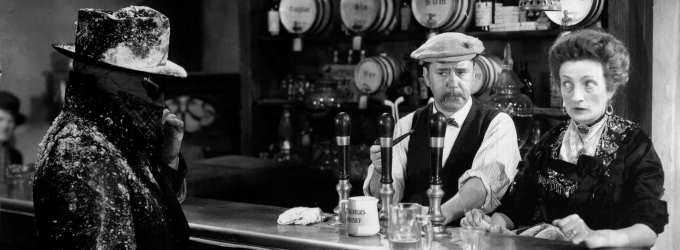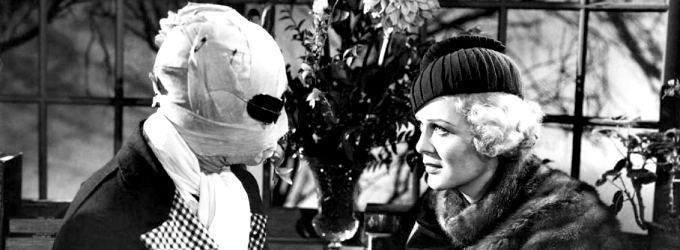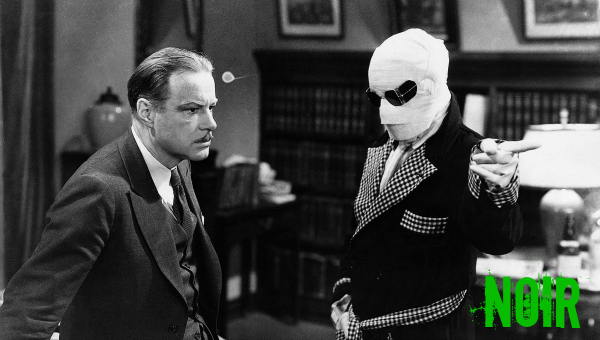 Nowadays, we tend to think of a very specific bunch of criteria when it comes to film noir.
Nowadays, we tend to think of a very specific bunch of criteria when it comes to film noir.
In the first place there’s the femme fatale, like GILDA: the powerful sexual predator who has all the men in her thrall. In the second place, we’re inclined to associate a gumshoe with the style: someone in the Humphrey Bogart vein, slouching about in a homburg hat and delivering monologues of a moody and cynical nature whilst cigarette smoke billows across the screen. Perhaps the quintessential film noir of this kind is THE MALTESE FALCON. But that might be seen as the final expression of a film style which until that point had been morphing, developing and anarchically defying anyone who really tried to define it. It’s still a genre that gives critics trouble.
‘how can I handcuff a bloomin’ shirt?’
It’s probably safest, then, to look at its roots rather than examine its results. Long before the Falcon took flight, film noir was busy bubbling up in the German Expressionist scene, and when the artists fled Nazi Germany, they took with them a number of camera men. And so it was that the aesthetic started to insinuate its way into Hollywood and beyond. How the camera man on THE MALTESE FALCON, Arthur Edeson, became inspired by the style is hard to know, however. He wasn’t German, but clearly had a natural affinity for Expressionism and that other stalwart of the film noir: melodrama. His THE INVISIBLE MAN of 1933, the predecessor of THE MALTESE FALCON, holds the key to much of what happened next. But the best thing about THE INVISIBLE MAN is its chilling realism, offset by the comedy.
Even if you’ve seen it on a rainy Sunday afternoon, you may by now have forgotten the many comic moments the film affords. With the basic premise that an invisible man is about to bend the world to his mad and mischievous will, the plot is a sort of romp with scenes of flying jugs and beer glasses; pyjamas walking about on their own; trousers with no body apparently chasing people down the street; and more besides. The characters include Una O’Connor as the hysterical landlady (a tour de force) and a proper comedy policeman with droopy moustache (E.E. Clive) who has lines like, ‘he’s invisible, that’s whats the matter with him’ and ‘how can I handcuff a bloomin’ shirt?’
It might sound like the film just sends itself up: but actually, the comedy gives it credibility. We enjoy the fantasy of the low-life world created by THE MALTESE FALCON; it’s certainly bewitching. But the power of THE INVISIBLE MAN lies in the fact that it seems almost as if it could really happen. These are real people living in a world we recognise – it’s got a pub in it! And into this normal community, with its innocent japes, stumbles a strange and horrifyingly real man. With his false nose and glasses he ought to be a joke, but of course, he isn’t. And when people start being strangled and clonked on the head for good n’ all, the dismay produced is genuine.
… he descends from mischief to madness and then comes to a sudden sense of self realisation just before death …
Of course, there is no femme fatale – unless you count the landlady or the ingenue, neither of whom are exactly sultry. And the plodding plod is not what you’d describe as a sleuth. But the German Expressionism is clear in the central character: a Goethesque figure if ever there was one, as he descends from mischief to madness and then comes to a sudden sense of self realisation just before death. Not a funny trajectory, when it comes down to it. Noir, as the name says, is all about shadow (which is the other reason it’s sensible to look at it from the point of view of the camera man), but as any good photographer will know, you only see the shadow by the light. How much more tension could have been produced in later films, had the comedy been more strongly defined against the brooding and horrifying elements which persisited? THE MALTESE FALCON almost goes there, in fact: when Bogart’s partner has been shot and he gives a description of him dressing up and licking his lips in anticipation of a date with his murderer, how much more powerful would the horror of that moment have been had we seen the partner standing at the mirror for some while, trying on this or that hat in a way which amused us … only to be shot a moment later? The scene is implied, for sure, but too understated to really break the rhythm of Bogart’s terse and monochrome style.
… with just a touch more comedy, would THE MALTESE FALCON have been more powerful still?
Shadow followed by shadow with not much light in between flits in front of the eyes with a mesmeric rhythm. And that’s what hypnotised the mass audience for the genre in the end. Not its aspirations to German art, or its potential to truly shock, but its lovely fashionable frocks and a world that is attractively remote and unworrying – not too harsh on the eye after a few pints. Once noir had created itself as a style it had lost some of its substance. It’s impossible to take away from the genius of a film like THE MALTESE FALCON, but with just a touch more comedy, would it have been more powerful still? Did film-makers ditch too much of the comedy when they created noir in the chic of the moment? Did we in fact, sacrifice substance to style in a way which left this genre as a redundant but rather nice fashion item of a bygone time?
httpvh://youtu.be/evx_Ps85yu8

